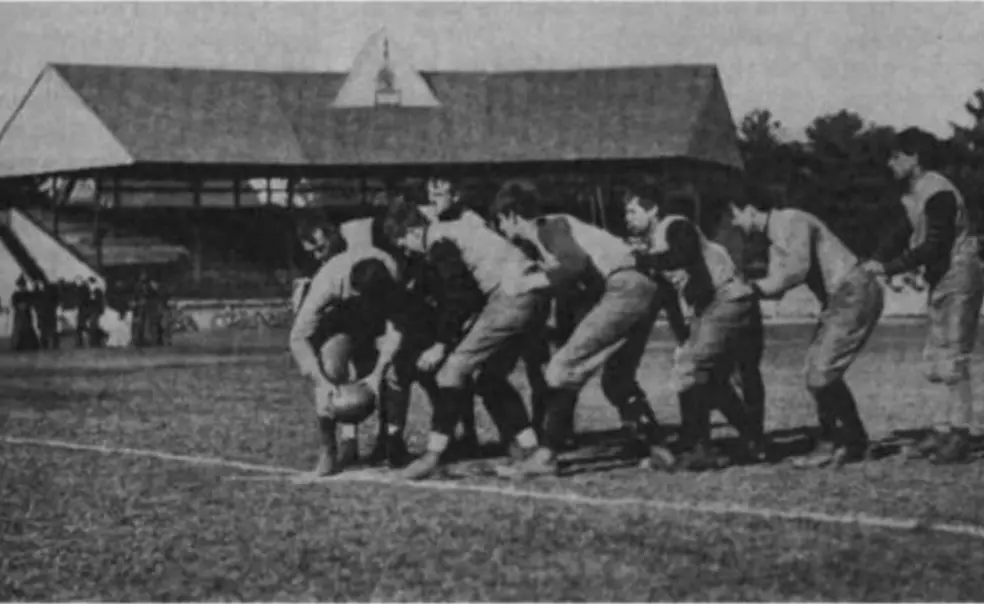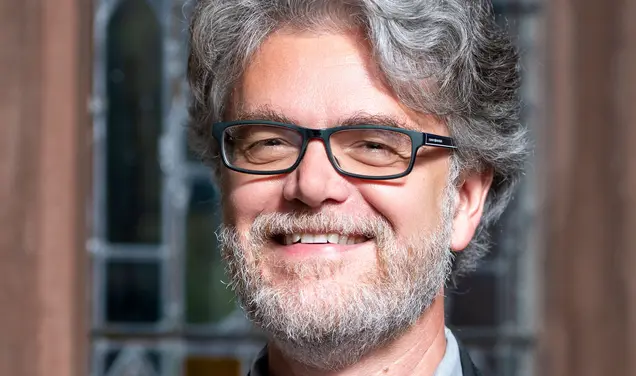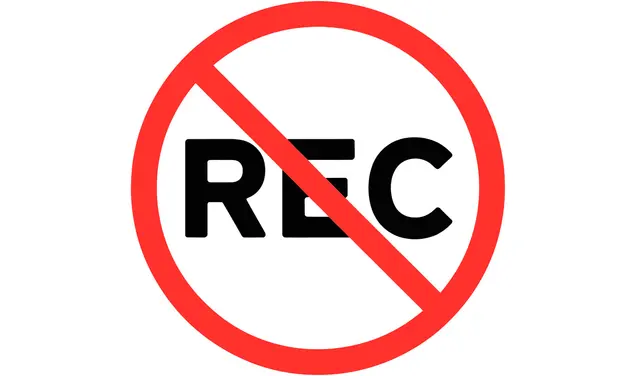Woodrow Wilson ’79’s Role in Football
Wilson had more to do with football than just about any other American President, before or since. Unlike Jerry Ford, he never played on an organized team, but he coached on, and participated in two of the most significant sets of rules changes to shape the game.
Stephen R. Dujack ’76 is PAW’s assistant editor. This is the third installment in our series commemorating the centennial of Woodrow Wilson’s graduation from Princeton.
While Woodrow Wilson 1879 was in the White House, he received a letter from Knox Taylor ’95, a temporary chairman of Princeton’s Board of Athletic Control, seeking the President’s advice on the university’s stumbling football team. The 1914 season had just ended, and for the third straight year the Tigers had been unable to beat either Harvard or Yale. Knox planned “to work out a general coaching arrangement with a view to permanency rather than for just the one year,” as had been the case, hoping to enter “a new era in Princeton’s football history.” Wilson replied: “The real trouble with our teams is that they are coached too much…I think you would find that if the players were not constantly nervous lest they should be criticized and censured by the coaches for not doing exactly what they were told, they would play with a new dash and vigor that would surprise everybody.”
Wilson had more to do with football than just about any other American President, before or since. Unlike Jerry Ford, he never played on an organized team, but he coached on, and participated in two of the most significant sets of rules changes to shape the game. During his student years, he supported the university’s team in Princetonian editorials, served as an undergraduate director of the Football Association, and championed the switch from soccer-style to Rugby-style rules. Later, he defended the sport against those who felt it had become too brutal, and even helped to make it more violent. Yet after the turn of the century, when the rising casualty rate incited widespread demands for football’s abolition, he had a hand in the reforms that not only saved the game but marked the beginning of its modern era.
How important was football to the slight and often ailing scholar-politician, of whom Professor George McLean Harper ’84 said, “I had never known him to indulge in any sport?” In two of his most triumphant moments – the hours following his election to the Governorship of New Jersey and the Presidency of the U.S. – he went to see the Princeton football team. In 1910, he prepped the squad for the Yale game with a half-hour talk on “Sports for Sport’s Sake.” He expected to watch the contest with great satisfaction that week, he said, because the new rules just put into effect (though not as far-reaching as those he had urged) had made it much more enjoyable for spectators. And in 1912 he took a rambling, five-mile hike around Princeton, stopping to sit in the grandstand during afternoon practice. “Two or three of the graduate coaches were the first to see him, and ran over to shake hands,” a newspaper records. “The football players kept at their scrimmage and kicking just as if the next President of the United States wasn’t looking on.”
At the time of Wilson’s birth, in 1856, association (soccer) football was being played between gigantic teams on the Princeton campus, using East and West Colleges as the goals, but the game was largely unknown outside the Northeast. During his year at Davidson College in Virginia – where he was regarded as “witty, genial, superior, but languid” – the big sport was baseball. As Ray Stannard Baker records in his biography of Wilson, “He did play center field in the baseball games and was an average batter, but Robert Glenn, captain of the team, afterward Governor of North Carolina, remarked explosively: ‘Tommy Wilson would be a good player if he weren’t so damned lazy.’” Wilson, however, saw the sport as recreation, “my chief solace,” he wrote in the 1880s.
At Princeton, Wilson often took part in pick-up games, and was elected president of the Base Ball Association in his senior year. Meanwhile, intercollegiate football was getting underway. Princeton had met Yale for the first time, in 1873, under soccer rules. Two years later Harvard played its inaugural match with Yale, under Rugby rules. On the sidelines were Jotham Potter 1877 and Wilson’s classmate and, later, clubmate Earl Dodge. The two were so taken by the Rugby version that they pushed for its adoption by Princeton. At a mass meeting in November 1876 the student body passed the new rules, which had the effect of merging the New England and Mid-Atlantic “leagues” and made possible the first game between Princeton and Harvard. Princeton then invited Columbia, Harvard, and Yale to a convocation later in the month at which the Intercollegiate Football Association was formed and a set of Rugby-style rules adopted.
The first season under the new rules was a poor one for Princeton, which finished with a 2-1-1 record, its worst ever (it had only lost twice before, once in the inaugural game). That spring, Dodge quit his upcoming captaincy of the team. Wilson complimented his classmate for his “splendid work” in a Prince editorial. Then at the season’s start, he took up Dodge’s campaign in another editorial rebutting a recent magazine article which had condemned Rugby football for being “most brutal and dangerous”:
The picture thus drawn is really horrible, and one likely to prejudice the ignorant against the game. But according to our American standard of experience, the account is most untrue. Some among us, who often look on but never play, believe that the danger is very great, and many outsiders, who witnessed the games last autumn, think…that the law should forbid such rough and dangerous sport. We speak to men who reason, in this way, for we will need all possible support this year, and in order to secure such support, all croakers in our midst must be silenced. Rugby has a great advantage over the association game in the substitution of ‘tackling’ for ‘bucking’ and any one who has experienced both ways of reaching the ground, must prefer an embrace and easy tumble to the violent jar and fall following a hard blow from an enemy’s shoulder.
Of course, as a director and secretary of the Football Association, Wilson may have been biased. He worked on plays with the new captain and urged discipline. The team beat Harvard and Yale (for the first H-Y-P championship) and went undefeated, allowing only one goal all fall. “Certainly the issue of the foot-ball season affords us every reason for self gratulation,” he wrote in the Prince after the schedule was concluded. He later explained that Princeton had “played a more scientific game than our opponents did.” The season was also successful financially: Wilson had raised the ticket price to 50¢ and the team had donated $100 to the Base Ball Association.
While Wilson was studying law at Virginia and political science at Johns Hopkins, and teaching at Bryn Mawr, the evolution of football continued. In the early 1880s, Princeton invented the “block game” – the Tigers held on to the ball for the entire, 45-minute half. The IFA countered by instituting the system of downs. During these years, the rules were in constant flux, and the collegians bent themselves to discovering and exploiting loopholes in them. In 1884, for example, strategists at both Princeton and Lehigh noticed that nothing in the rules mandated that a kickoff go to the opponent. Princeton first took advantage of this loophole in the 1884 Pennsylvania game with its “V trick” – the quarterback kicked off to himself and ran inside a wedge formed from his 10 teammates with their arms linked. This was the first instance of what came to be called the “mass play,” the violent rush of men that frequently left participants unconscious, maimed, or dead. Though the formation produced a long gain on its first trial, it was abandoned till 1888, when it was used against Yale.
Then Harvard invented the flying wedge – the first momentum mass p lay, sort of a “V trick” with a running start – at the suggestion of a chess-playing student. Football games became strategy contests, collisions of formations always described as “engines” of destruction. Though slugging was outlawed in 1885 at Harvard’s insistence, John L. Sullivan, heavyweight boxing champion, said after a Harvard-Yale match: “There’s murder in that game.” (One of the most formidable mass plays was invented by Yale Coach Walter Camp, who said he had quit medical school because he couldn’t bear the sight of blood.)
In 1889, a year after his appointment at Wesleyan, Wilson was voted the faculty representative to the Football Association by acclamation. All that fall he and the team captain worked on developing their own mass play. Wilson also devised “rotation plays” – a series of pre-called plays – and something termed “the double criss-cross pass.” His team laid waste to the small colleges on its schedule, only to be decimated by the Big Three. Nonetheless, Wilson railed against the attitude that the best a small college could do in a Big Three game was to hold down its opponent’s score: “That’s no ambition at all, go in and win; you can lick Yale as well as any other team. Go after their scalps. Don’t admit for a moment that they can beat you.” Though Yale triumphed, 52-0, for the first time in years none of the Big Three exceeded 100 points against Wesleyan.
Late in the season, Wilson took his team to Springfield, Massachusetts, to play Lehigh. The game paired the acknowledged small-college leaders of the Northeast and the Mid-Atlantic, and Lehigh had been arguing that a win should give it the right to replace Wesleyan in the IFA. After the Engineers grabbed an early two-touchdown lead on the muddy field, the Wesleyan stands fell silent.
“Then suddenly from the bleachers, a man, wearing a black raincoat, heavy rubber boots and carrying a rolled umbrella, came out to face the glum Cardinal fans from the sidelines,” relates Princeton’s former assistant director of public information, John Fenton, Wesleyan 1953. “Even garbed as he was against the heavy weather, the students instantly recognized Professor Wilson. He chided them for not cheering, urgently, ‘Now is just the time to yell.’ Whereupon he began to lead them in the Cardinal cheer…all the while beating out the rhythm with his umbrella. The stands came alive, the team responded.” And Wesleyan went on to eke out an 11-11 tie. The future Peace Prizewinner was said to have often run out on the field when he questioned an official’s judgment, and to have shouted “kill him, kill him,” when an opponent fouled one of his players.

As his scholarly reputation grew, the professor still talked of football. “Princeton is noted in the wide world for three things,” he told the Alumni Association of Maryland in 1894, “football, baseball, and collegiate instruction.” He went on to defend the sport against those who criticized its violence: “The religious press declares the game to be dangerous because of the ‘masse plays.’ Now, I don’t believe the men who write these critiques know what masse plays are. The men who were killed last year playing foot-ball were not killed in masse plays, but in open plays.” At the conclusion of his speech, he said, “If the men don’t play football, they will play less legitimate games.”
In the light of Harvard’s recent resumption of a core curriculum much like Princeton’s system of distribution requirements, it is interesting to note that in 1894 Wilson asked, “Why is it that Harvard don’t win in football? President Eliot says they don’t play well because of the elective system of studies, and I think he is practically right. The elective man is never subject to discipline.” Throughout the 1890s, Wilson touched on three themes: that football built moral character, aided academics, and that its leadership ought to be in the province of the players.
Just after the turn of the century, Wilson and two other members of the Faculty Committee on Outdoor Sports wrote in a letter to PAW, “Princeton is the only one of the larger universities which does not already possess permanent stands.” They announced that a generous alumnus had provided $1,000 to “start the ball rolling.” The bleachers were built that fall, but University Field still could not seat all the spectators who came. The problem cited by the Faculty Committee was not solved until 1914 when Palmer Stadium was completed.
Even so, University Field was the site for the 1905 Army-Navy game, attended by Theodore Roosevelt, Wilson had only recently started the precept system and seemed more interested in Princeton in the Nation’s Service than in the Services at Princeton, wrote English Professor J. Duncan Spaeth. The two presidents met at the train station and lunched together, with many dignitaries in attendance. At half-time, when the U.S. President traditionally changes sides, Roosevelt set out in bully fashion, with the academician in tow. “Who would have dared to predict that in less than ten years the college professor would be in the White House,” Spaeth commented, “and only a little later the erstwhile President and Rough-Rider would be asking Wilson as his commander-in-chief for permission to lead an American division in a European war?”
A month earlier, Army had lost its left tackle, Eugene A. Byrne, who died of injuries sustained paying Harvard. He was one of 18 players to die that year, and another 159 were seriously injured. Byrne’s death led to “a crisis in football’s existence,” as Dean Hill put it in Football Thru the Years. “The game was fiercely criticized and attacked in all parts of the country and was even abolished at a number of colleges.” In response, Wilson and the Faculty Committee on Outdoor Sports proposed rule changes “Princeton believes to be essential for the proper reformation of the game.” Wilson dropped one of his banners by suggesting the elimination of the mass play, held onto another by insisting on amateur coaching, and also asked for a shorter season.
Roosevelt called a meeting of representatives of the Big Three at the White House and urged them to take steps to save the game. In addition, NYU Chancellor Henry Mitchell MacCracken set up a conclave of 62 colleges, Wilson wrote MacCracken that Princeton’s proposals were “so definite and comprehensive that we could go into such a conference…only to urge our own conclusions.” Nonetheless, the meeting was held and a new rules committee was formed, headed by Army’s Palmer E. Pierce. It met with the established panel, headed by Camp, and in January 1906 they merged to form the Intercollegiate Football Rules Committee, which later became the NCAA. The chief product of these sessions was the legalization of the forward pass, which was expected to open up the game and render the mass play obsolete. No mention was made of amateur coaching or of reducing the season, though the length of the game was lessened to 60 minutes.
After two seasons under the new rules, Wilson said, “The game is a better one, but it must be made still better. I believe, however, that it is following a natural course, and will soon reach the desired high plane.” But the dust had not yet settled. A December 1909 editorial in Harper’s Weekly asked of the Big Three presidents: “Dr. Hadley, Dr. Lowell, Dr. Wilson, don’t you think football, as it was played this year, is a little rough? There had been 27 deaths up to November 21st, gentlemen…You could stop this kind of football if you chose, you three men. The mothers can’t, poor souls.”
Wilson responded by writing Lowell and Hadley two days later urging “an informal conference…to save a very noble game.” A flurry of letters between Cambridge, New Haven, and Princeton followed, and representatives were selected for each school; Yale, naturally, chose Camp. Wilson wanted changes that would not only reduce injury, but enhance the character of the sport. The bureaucratic hassling over what the conference would discuss, as well as when and where, consumed many months, so it was not until May 1910 that the new rules were finished. Perhaps because his Elis had just finished an unscored-upon season, Camp dissented from any change. But Hadley silenced him by telling the managers in the league that “there will be no football games at the Yale Field next fall except under rules substantially safer than those of last year.”
In June the IFRC met at the behest of the Big Three and adopted the same reforms. Camp refused to sign the report because he felt the rules were too strict; Wilson accepted them but complained that they were too lax. The changes included prohibition of diving tackles, protection for pass receivers, and final elimination of the mass play by forbidding blockers to interlock their arms or make contact with the ballcarrier. It was the following fall’s Princeton-Yale game that Governor-Elect Wilson expected to enjoy so much because of the improvements brought about by the new rules. Moreover, the Tigers were 7-0 going into the contest, without a single point scored against them. But Yale won, 5-3.
This was originally published in the December 18, 1978 issue of PAW.











No responses yet